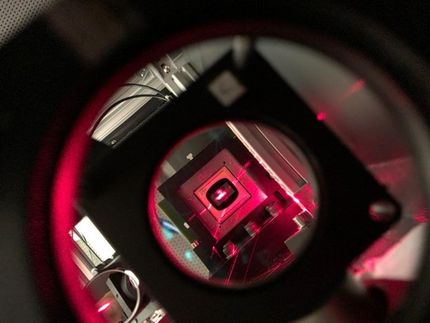Quantum diffraction at a breath of nothing
Physicists build stable diffraction structure in atomically thin graphene
quantum physics tell us that even massive particles can behave like waves, as if they could be in several places at once. This phenomenon is typically proven in the diffraction of a matter wave at a grating. In a European collaboration, researchers carried this idea to the extreme and observed the delocalization of molecules at the thinnest possible grating, a mask milled into a single layer of atoms. The presented experiments explore the technical limits of matter wave technologies and respond to a famous Gedanken experiment by Einstein and Bohr of almost 80 years ago.
The research in the group around Prof. Markus Arndt at the University of Vienna is focused on how one can extend such technologies to large molecules and cluster.
At the technological limit
In a European collaboration (NANOQUESTFIT) together with partners around Professor Ori Cheshnovsky at Tel Aviv University (where all nanomasks were written), as well as with support by groups in Jena (growth of biphenyl membranes, Prof. Turchanin), and Vienna (High-Resolution Electron Microscopy, Prof. Meyer) they now demonstrated for the first time that such gratings can be fabricated even from the thinnest conceivable membranes. They milled transmission masks into ultra-thin membranes of silicon nitride, biphenyl molecules or carbon with a focussed ion beam and analysed them with ultra-high resolution electron microscopy. The team succeeded in fabricating stable and sufficiently large gratings even in atomically thin single layer graphene.
"These are the thinnest possible diffraction masks for matter wave optics. And they do their job very well", says Christian Brand, the lead author of this publication. "Given the gratings’ thickness of a millionth of a millimetre, the interaction time between the mask and the molecule is roughly a trillion times shorter than a second. We see that this is compatible with high contrast quantum interference".
A thought experiment of Bohr and Einstein
The bars of the nanogratings look resemble the strings of a miniature harp. One may therefore wonder whether the molecules induce vibrations in these strings when they are deflected to the left or the right during quantum diffraction. If this were the case the grating bars could reveal the molecular path through the grating and quantum interference should be destroyed. The experiment thus realizes a thought experiment that was discussed by Nils Bohr and Albert Einstein already decades ago: They asked whether it is possible to know the path a quantum takes through a double slit while observing its wave nature. The solution to this riddle is again provided by Heisenberg’s uncertainty principle: Although the molecules give the grating a little kick in the diffraction process this recoil remains always smaller than the quantum mechanical momentum uncertainty of the grating itself. It therefore remains undetectable. Here it is shown that this applies even to membranes that are only one atom thick.
Original publication
Other news from the department science

Get the analytics and lab tech industry in your inbox
By submitting this form you agree that LUMITOS AG will send you the newsletter(s) selected above by email. Your data will not be passed on to third parties. Your data will be stored and processed in accordance with our data protection regulations. LUMITOS may contact you by email for the purpose of advertising or market and opinion surveys. You can revoke your consent at any time without giving reasons to LUMITOS AG, Ernst-Augustin-Str. 2, 12489 Berlin, Germany or by e-mail at revoke@lumitos.com with effect for the future. In addition, each email contains a link to unsubscribe from the corresponding newsletter.


















































